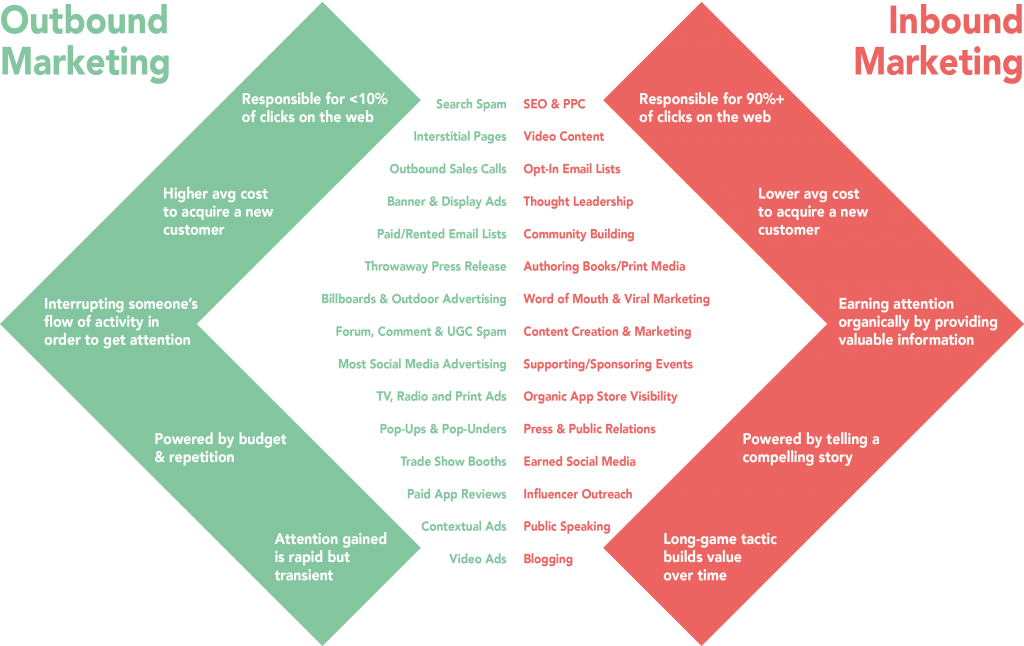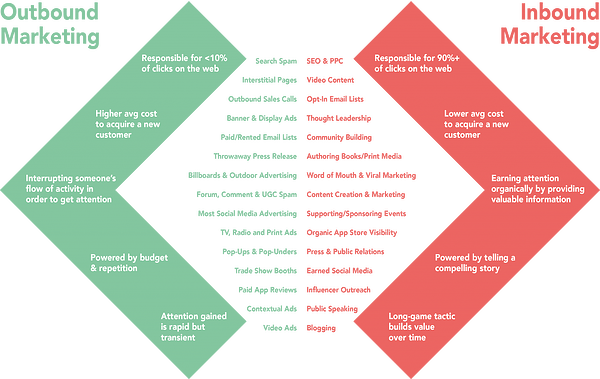Life science marketers have a huge array of tactics to choose from when it comes to reaching, engaging and influencing their targets. As part of the programmes we plan with our clients, one of the key questions we are asked is whether to use inbound or outbound tactics. The answer is not simple and often involves taking advantage of both approaches, as I hope to convince you in today’s blog.
Inbound marketing offers significant benefits
Now, I’m the office geek, but I don’t mind. Reading about and staying on top of all the latest marketing tactics and strategic approaches is something I do for pure enjoyment. Over the last few years, I’ve watched with interest as the ‘Inbound Marketing movement’ has gained momentum, to the point where it’s now snowballing down the hill and a term that is on the lips of most marketers.
Driven by thought leaders such as the great Seth Godin, Brian Halligan and Dharmesh Shah of Hubspot and David Meerman Scott (see below for some further reading from these guys), the main premise of life science inbound marketing is to attract customers to you by creating valuable and relevant content they want to consume.
As you might have guessed, the end goal is usually to get customers to visit your website (where the content is housed). You then attempt to direct them on to other areas of your website, either to consume more content or to take a step closer to making a purchase (e.g. fill in a ‘contact us’ form or add a product to an online shopping basket).
Many marketers are turning to inbound methods as they offer a number of benefits:
- Building a direct audience and relying less on paid-for media (i.e. ‘earning and owning’ attention rather than ‘renting’ it)
- Promoting internal expertise via thought leadership content
- Delivering value to customers and prospects, as opposed to using ‘interruption’ tactics (which are often poorly targeted and can end up annoying recipients that are not interested in the message)
- Improving organic search engine rankings through specific keyword usage (while also encouraging spiders to visit a site more often)
- Increasing the frequency of touch points with the company brand
- Helping to nurture customers through the sales cycle by using content designed to move them down the sales funnel
Why consider outbound marketing?
Given all these benefits, the answer is simple, right? Adopt the inbound methodology with gusto? Not so fast.
Planning a marketing strategy is about identifying your short- and long-term goals, assessing your budget, reviewing the competitive landscape and selecting the tactics that you think will help you win in your marketplace. While life science inbound marketing is often seen as cheaper than outbound marketing, it is also a ‘long-game tactic’ – value is built incrementally over time, as more and more prospects learn about a company and engage with the brand.
On the other hand, outbound marketing tactics can often be ‘expensive’ in terms of cost outlay, but they can also deliver instant results by enabling companies to reach a large amount of people quickly. For example, widespread advertising in key print journals and trade websites can be used to rapidly raise awareness among a large number of people, while email blasts employing rented lists can deliver a large number of tangible leads (especially if the list has been carefully chosen to ensure the recipients will be interested in the offer promoted).
Outbound versus inbound and the need for context
To illustrate the point even further, let’s look at a couple of examples. It should be noted that these examples are highly simplistic; the best course of action depends on a detailed analysis of the situation, e.g. competitive landscape, market awareness, strengths/weaknesses against competitors, budget etc., the likes of which is beyond the scope of this blog. In both cases indicated below, I ultimately suggest combining outbound and inbound approaches at different times in the programme. These are by no means the only solutions in each case, nor does it imply that the optimal tactical mix can be selected using such little information.The point is more to imply that outbound can play a role in most cases, although the precise tactic (and amount of budget that should be allocated) can vary significantly.
So, back to the examples. What tactics should a large multinational company with an extensive internal marketing team and a significant budget use when moving into a new market? As a new player, the company in question is unlikely to be well known by this new set of target customers. Furthermore, it is may not yet to be able to demonstrate much evidence of experience, expertise or a track record of thought leadership in this new market; this could make it challenging to create compelling and detailed content that will be accepted and believed by prospective customers.
In this case, the company needs a strong and clear value proposition, which is then rapidly delivered to a large audience through paid-for channels such as print advertising and email marketing. Once the company has raised awareness in this way, it can employ inbound tactics to nurture prospects along the buying journey, for example using whitepapers or technical notes illustrating why its approach/technology/products/services are now the best solution. This is especially effective in highly technical markets like scientific research tools, healthcare and diagnostics, where true insights on a topic are highly valued by target customers, whether it teaches them about a subject or helps them make a purchase decision.
Turning this example on its head, what should a small, innovative company do when trying to take on a global incumbent? One thing’s for sure, it’s unlikely to be able to steal market share by sheer force, such as buying up all available ad space or mobilising a large sales team to start pulling in sales. In this case, budget might be more effectively utilised by identifying the subset of the market that will really benefit from the company’s solution and then directly marketing to them in a way that demonstrates the value offered. In the first case, this could be done by creating whitepapers or application notes showing the product/service in action. This content can then be shared via internal email lists or by using a highly targeted pay-per-click campaign (e.g. using Google AdWords). In this case, a carefully selected third party email list could also help to bolster the reach of the campaign, without breaking the bank.
These are very simplistic examples, but hopefully they serve to highlight the situation analysis that must be done before selecting which mix of inbound and outbound marketing tactics to use.
Which should you choose?
So, while inbound tactics can offer a lot of value, I hope I’ve demonstrated that there are also times when traditional outbound approaches can still provide significant results.
To help you differentiate between the relative merits of the two, as well as which tactics typically fall into which group, we put together the graphic below. It’s based on an excellent graphic originally produced by the team over at Moz (formally SEOmoz), which you can find here, in a blog post by Rand Fishkin. We interpret the processes slighlty different from the Moz team, hence creating our own graphic.
As you’ll notice, our graphic is slightly more agnostic when it comes to the pros and cons of the different approaches. Instead, we believe that an optimal tactical mix tends to draw upon both inbound and outbound tactics – each programme is different, with different objectives, budget constraints and resource materials, so it’s important to review your unique situation when planning yours.
Note: This blog was edited on 16 October 2014, see the comments below for more details.
Further reading:
- Inbound Marketing, Revised and Updated: Attract, Engage, and Delight Customers Online by Brian Halligan and Dharmesh Shah
- The New Rules of Marketing & PR by David Meerman Scott
- Permission Marketing by Seth Godin





